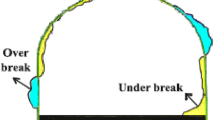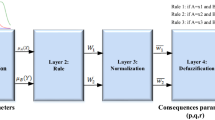Abstract
The drilling and blasting technique is among the common techniques for excavating tunnels with different shapes and sizes. Nevertheless, due to the dynamic energy involved, the rock mass around the excavation zone experiences damage and reduction in stiffness and strength. One of the most common and important issues that occurs during the tunneling process is the overbreak which is defined as the surplus drilled section of the tunnel. It seems that prediction of overbreak before blasting operations is necessary to minimize the possible damages. This paper develops a new hybrid model, namely, an artificial bee colony (ABC)–artificial neural network (ANN) to predict overbreak. Considering the most important parameters on overbreak, many ABC–ANN models were constructed based on their effective parameters. A pre-developed ANN model was also developed for comparison. In order to evaluate the obtained results of this study, a new system, i.e., the color intensity rating (CIR), was introduced and established to select the best ABC–ANN and ANN models. As a result, the ABC–ANN receives a high level of accuracy in predicting overbreak induced by drilling and blasting. The coefficients of determination (R2) for the ANN and ABC–ANN are 0.9121 and 0.9428, respectively, for training datasets. This revealed that the ABC–ANN model (as a new model in the field of this study) is the best one among the models developed in this study.












Similar content being viewed by others
References
Ahmad A, Razali SFM, Mohamed ZS, El-shafie A (2016) The application of artificial bee colony and gravitational search algorithm in reservoir optimization. Water Resour Manag 30:2497–2516
Armaghani DJ, Mohamad ET, Narayanasamy MS et al (2017) Development of hybrid intelligent models for predicting TBM penetration rate in hard rock condition. Tunn Undergr Sp Technol 63:29–43. https://doi.org/10.1016/j.tust.2016.12.009
Bhandari S (1997) Engineering rock blasting operations. A A Balkema 388:388
de Oliveira IMS, Schirru R, de Medeiros J (2009) On the performance of an artificial bee colony optimization algorithm applied to the accident diagnosis in a pwr nuclear power plant. In: 2009 International nuclear Atlantic conference (INAC 2009)
Ebrahimi E, Monjezi M, Khalesi MR, Armaghani DJ (2016) Prediction and optimization of back-break and rock fragmentation using an artificial neural network and a bee colony algorithm. Bull Eng Geol Environ 75:27–36
Engelbrecht AP (2007) Computational intelligence: an introduction. Wiley, Hoboken
Esmaeili M, Osanloo M, Rashidinejad F et al (2014) Multiple regression, ANN and ANFIS models for prediction of backbreak in the open pit blasting. Eng Comput 30:549–558
Fausett L, Fausett L (1994) Fundamentals of neural networks: architectures, algorithms, and applications. Prentice-Hall, Upper Saddle River
Garrett JH (1994) Where and why artificial neural networks are applicable in civil engineering. J Comput Civil Eng 8(2):129–130
Gates WCB, Ortiz LT, Florez RM (2005) Analysis of rockfall and blasting backbreak problems, US 550, Molas Pass, CO. In: Alaska Rocks 2005, the 40th US symposium on rock mechanics (USRMS). American Rock Mechanics Association
Ghaleini EN, Koopialipoor M, Momenzadeh M, Sarafraz ME, Mohamad ET, Gordan B (2018) A combination of artificial bee colony and neural network for approximating the safety factor of retaining walls. Eng Comput. https://doi.org/10.1007/s00366-018-0625-3
Gordan B, Jahed Armaghani D, Hajihassani M, Monjezi M (2016) Prediction of seismic slope stability through combination of particle swarm optimization and neural network. Eng Comput. https://doi.org/10.1007/s00366-015-0400-7
Gordan B, Koopialipoor M, Clementking A, Tootoonchi H, Mohamad ET (2018) Estimating and optimizing safety factors of retaining wall through neural network and bee colony techniques. Eng Comput. https://doi.org/10.1007/s00366-018-0642-2
Grima MA, Bruines PA, Verhoef PNW (2000) Modeling tunnel boring machine performance by neuro-fuzzy methods. Tunn Undergr Sp Technol 15:259–269
Hajihassani M, Jahed Armaghani D, Monjezi M et al (2015) Blast-induced air and ground vibration prediction: a particle swarm optimization-based artificial neural network approach. Environ Earth Sci 74:2799–2817. https://doi.org/10.1007/s12665-015-4274-1
Hasanipanah M, Armaghani DJ, Amnieh HB, Koopialipoor M, Arab H (2018) A risk-based technique to analyze flyrock results through rock engineering system. Geotech Geol Eng 36(4):2247–2260. https://doi.org/10.1007/s10706-018-0459-1
Haykin S, Network N (2004) A comprehensive foundation. Neural Netw 2:41
Hecht-Nielsen R (1989) Kolmogorov’s mapping neural network existence theorem. In: Proceedings of the international joint conference in neural networks, pp 11–14
Hornik K, Stinchcombe M, White H (1989) Multilayer feedforward networks are universal approximators. Neural Netw 2:359–366
Ibarra JA, Maerz NH, Franklin JA (1996) Overbreak and under-break in underground openings part 2: causes and implications. Geotech Geol Eng 14:325–340
Irani R, Nasimi R (2011) Application of artificial bee colony-based neural network in bottom hole pressure prediction in underbalanced drilling. J Pet Sci Eng 78:6–12
Jahed Armaghani D, Hajihassani M, Monjezi M et al (2015) Application of two intelligent systems in predicting environmental impacts of quarry blasting. Arab J Geosci 8:9647–9665. https://doi.org/10.1007/s12517-015-1908-2
Jahed Armaghani D, Tonnizam Mohamad E, Hajihassani M et al (2016) Evaluation and prediction of flyrock resulting from blasting operations using empirical and computational methods. Eng Comput. https://doi.org/10.1007/s00366-015-0402-5
Jang H, Topal E (2013) Optimizing overbreak prediction based on geological parameters comparing multiple regression analysis and artificial neural network. Tunn Undergr Sp Technol 38:161–169
Kaastra I, Boyd M (1996) Designing a neural network for forecasting financial and economic time series. Neurocomputing 10:215–236
Kanellopoulos I, Wilkinson GG (1997) Strategies and best practice for neural network image classification. Int J Remote Sens 18:711–725
Karaboga D (2005) An idea based on honey bee swarm for numerical optimization. Technical report-tr06, Erciyes University, Engineering Faculty, Computer Engineering Department
Karaboga D, Akay B (2007) Artificial bee colony (ABC) algorithm on training artificial neural networks. In: Signal processing and communications applications, 2007. SIU 2007. IEEE 15th. IEEE, pp 1–4
Karaboga D, Basturk B (2007) A powerful and efficient algorithm for numerical function optimization: artificial bee colony (ABC) algorithm. J Glob Optim 39:459–471
Koopialipoor M, Armaghani DJ, Haghighi M, Ghaleini EN (2017) A neuro-genetic predictive model to approximate overbreak induced by drilling and blasting operation in tunnels. Bull Eng Geol Environ. https://doi.org/10.1007/s10064-017-1116-2
Koopialipoor M, Armaghani DJ, Hedayat A et al (2018a) Applying various hybrid intelligent systems to evaluate and predict slope stability under static and dynamic conditions. Soft Comput. https://doi.org/10.1007/s00500-018-3253-3
Koopialipoor M, Fallah A, Armaghani DJ et al (2018b) Three hybrid intelligent models in estimating flyrock distance resulting from blasting. Eng Comput. https://doi.org/10.1007/s00366-018-0596-4
Koopialipoor M, Ghaleini EN, Haghighi M, Kanagarajan S, Maarefvand P, Mohamad ET (2018c) Overbreak prediction and optimization in tunnel using neural network and bee colony techniques. Eng Comput. https://doi.org/10.1007/s00366-018-0658-7
Koopialipoor M, Nikouei SS, Marto A, Fahimifar A, Armaghani DJ, Mohamad ET (2018d) Predicting tunnel boring machine performance through a new model based on the group method of data handling. Bull Eng Geol Environ. https://doi.org/10.1007/s10064-018-1349-8
Lundborg N (1974) The hazards of flyrock in rock blasting. Swedish Detonic Research Foundation, Reports DS 12, Stockholm
Maerz NH, Ibarra JA, Franklin JA (1996) Overbreak and under-break in underground openings Part 1: measurement using the light sectioning method and digital image processing. Geotech Geol Eng 14:307–323
Mandal SK, Singh MM (2009) Evaluating extent and causes of overbreak in tunnels. Tunn Undergr Sp Technol 24:22–36
Marto A, Hajihassani M, Jahed Armaghani D, Tonnizam Mohamad E, Makhtar AM (2014) A novel approach for blast-induced flyrock prediction based on imperialist competitive algorithm and artificial neural network. Sci World J. https://doi.org/10.1155/2014/643715
Masters T (1993) Practical neural network recipes in C++. Morgan Kaufmann, Burlington
McCulloch WS, Pitts W (1943) A logical calculus of the ideas immanent in nervous activity. Bull Math Biophys 5:115–133
Momeni E, Jahed Armaghani D, Hajihassani M, Mohd Amin MF (2015) Prediction of uniaxial compressive strength of rock samples using hybrid particle swarm optimization-based artificial neural networks. Meas J Int Meas Confed. https://doi.org/10.1016/j.measurement.2014.09.075
Monjezi M, Dehghani H (2008) Evaluation of effect of blasting pattern parameters on back break using neural networks. Int J Rock Mech Min Sci 45:1446–1453
Monjezi M, Ahmadi Z, Varjani AY, Khandelwal M (2013) Backbreak prediction in the Chadormalu iron mine using artificial neural network. Neural Comput Appl 23:1101–1107
Nozohour-leilabady B, Fazelabdolabadi B (2016) On the application of artificial bee colony (ABC) algorithm for optimization of well placements in fractured reservoirs; efficiency comparison with the particle swarm optimization (PSO) methodology. Petroleum 2:79–89
Ocak I, Seker SE (2013) Calculation of surface settlements caused by EPBM tunneling using artificial neural network, SVM, and Gaussian processes. Environ Earth Sci 70:1263–1276
Paola JD (1994) Neural network classification of multispectral imagery. Master Tezi, Univ Arizona, USA
Raina AK, Haldar A, Chakraborty AK et al (2004) Human response to blast-induced vibration and air-overpressure: an Indian scenario. Bull Eng Geol Environ 63:209–214
Raina AK, Murthy V, Soni AK (2014) Flyrock in bench blasting: a comprehensive review. Bull Eng Geol Environ 73:1199–1209
Ripley BD (1993) Statistical aspects of neural networks. Netw Chaos Stat Probab Asp 50:40–123
Rodriguez FJ, García-Martínez C, Blum C, Lozano M (2012) An artificial bee colony algorithm for the unrelated parallel machines scheduling problem. In: International conference on parallel problem solving from nature. Springer, pp 143–152
Roth J (1979) A model for the determination of flyrock range as a function of shot conditions. US Bureau of Mines contract J0387242. Manag Sci Assoc Los Altos
Saghatforoush A, Monjezi M, Faradonbeh RS, Armaghani DJ (2016) Combination of neural network and ant colony optimization algorithms for prediction and optimization of flyrock and back-break induced by blasting. Eng Comput 32:255–266
Singh SP, Xavier P (2005) Causes, impact and control of overbreak in underground excavations. Tunn Undergr Sp Technol 20:63–71
Wang C (1994) A theory of generalization in learning machines with neural network applications. Doctoral Dissertation, University of Pennsylvania, Philadelphia, PA, USA
Zhang C, Ouyang D, Ning J (2010) An artificial bee colony approach for clustering. Expert Syst Appl 37:4761–4767
Zorlu K, Gokceoglu C, Ocakoglu F et al (2008) Prediction of uniaxial compressive strength of sandstones using petrography-based models. Eng Geol 96:141–158
Acknowledgements
The authors would like to extend their appreciation to the manager, engineers and personnel of Forum708 (Otagh-MEH), for providing the needed information and facilities that made this research possible. Additionally, the authors would like to express their sincere appreciation to reviewers because of their valuable comments that increased the quality of our paper.
Author information
Authors and Affiliations
Corresponding author
Ethics declarations
Conflict of interest
The authors declare no conflict of interest.
Additional information
Publisher’s Note
Springer Nature remains neutral with regard to jurisdictional claims in published maps and institutional affiliations.
Rights and permissions
About this article
Cite this article
Koopialipoor, M., Ghaleini, E.N., Tootoonchi, H. et al. Developing a new intelligent technique to predict overbreak in tunnels using an artificial bee colony-based ANN. Environ Earth Sci 78, 165 (2019). https://doi.org/10.1007/s12665-019-8163-x
Received:
Accepted:
Published:
DOI: https://doi.org/10.1007/s12665-019-8163-x




